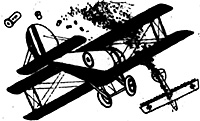 I am writing to tell you of some ideas which your books "War Games" and "Air War Games" sparked off.
I am writing to tell you of some ideas which your books "War Games" and "Air War Games" sparked off.
Firstly a method of suspending aircraft which you may not have heard of. A strawberry net on a frame is suspended over the battlefield. From this, pieces of cotton thread, with loops at regular intervals, are hung by wire hooks. The aircraft is held in a cradle made of a wire hook and a ring of cotton thread. In the tip of one of the aircraft's wings, a notch is made, using a hot pin held with pliers, similar in shape to that drawn. With care, this can be made small enough not to mar the models yet large enough to function effectively. To the bottom of the looped thread add a small weight as shown in the diagram. (I used brass curtain rollers). The method of using this is: With the thread running as shown through the wing-tip notch, the thread can be pulled sideways without coming out. The hook at the top of the looped thread and the net enable the plane to be placed anywhere beneficial, the other hook and the ring of thread and the loops enable the plane to "fly" at any height and altitude and the notch and and weight enable the plane to be pointed in any direction allow it to stay pointed in that direction.
 Since I have not a wargames table, all my battles take place on the floor. This means that using the Lionel Tarr periscope requires certain dexterity and physical contortion and this, coupled with the need to avoid placing hands and knees on tanks and houses, makes the whole act well nigh impossible. The following device can be looked down on to get the same effect and is an improvement
Since I have not a wargames table, all my battles take place on the floor. This means that using the Lionel Tarr periscope requires certain dexterity and physical contortion and this, coupled with the need to avoid placing hands and knees on tanks and houses, makes the whole act well nigh impossible. The following device can be looked down on to get the same effect and is an improvement
It uses just a mirror mounted in the bottom of a tube. To use, get the top of the opening just above the level of the figure's head and move the eye back and forth until the head and the top of the hill etc., are in line. If any of the target appears above the hill, it can be seen. To make this levelling the periscope with the head easier, a sliding band of paper could be built round the tube so that the top of the opening could be altered in height.
Modern Warfare
Finally, an idea for modern warfare. After the points value has been reached (with the dice) to destroy a tank with an anti-tank gun, a further dice is thrown to decide its fate. 1, 2, 3 all mean the tank is irretrievably damaged but 4, 5, 6. mean the dice must be thrown again. On this second throw, the following numbers convey:
- 1 tow back to the baseline of square.
2 tow back to the baseline of square
3 tow back to the baseline of square
4 tow back to the baseline of square or out of action for 3 moves.
5 tow back to the baseline of square or out of action for 2 moves.
6 tow back to the baseline of square or out of action for 1 move.
When the tank is back at its baseline, it must stay there 1 move after which time it can go back to the battle.
Back to Table of Contents -- Wargamer's Newsletter # 102
To Wargamer's Newsletter List of Issues
To MagWeb Master Magazine List
© Copyright 1970 by Donald Featherstone.
This article appears in MagWeb.com (Magazine Web) on the Internet World Wide Web.
Other articles from military history and related magazines are available at http://www.magweb.com